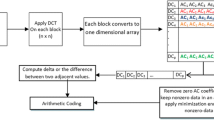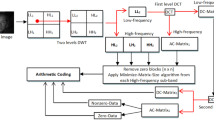Abstract
In this paper a novel method for 2D image compression is proposed and demonstrated through high quality reconstruction with compression ratios up to 99%. The proposed novel algorithm is based on a two-level discrete cosine transform (DCT) followed by Hexadata coding and arithmetic coding at compression stage. The novel method consists of four main steps: (1) a two-level DCT is applied to an image to reinforce the low frequency coefficients and increase the number of high frequency coefficients to facilitate the compression process; (2) the Hexadata coding algorithm is applied to each high frequency matrix separately through five different keys to reduce each matrix to 1/6 of their original size; (3) build a probability table of original high-frequency data required in the decoding step; and (4) apply arithmetic coding to compress each of the outputs of steps (2) and (3). At decompression stage, arithmetic decoding and a fast matching search algorithm (FMS-Algorithm) decodes the high frequency coefficients of step (2) using the probability table of step (3). Finally, two level inverse DCT is applied to decode the high frequency coefficients to reconstruct the image. The technique is demonstrated on still images including video streaming from YouTube. The results show that the proposed method yields high compression ratios up to 99% with better perceptual quality of reconstructed images as compared with the popular JPEG method.




















Similar content being viewed by others
References
Richardson, I. E. G. (2002). Video codec design. New York: Wiley.
Sayood, K. (2000). Introduction to data compression (2nd ed.). Cambridge: Academic Press.
Gonzalez, R. C., & Woods, R. E. (2001). Digital image processing. Boston: Addison Wesley Publishing Company.
Xie, Y., Yu, J., Guo, S., Ding, Q., & Wang, E. (2019). Image encryption scheme with compressed sensing based on new three-dimensional chaotic system. Entropy, 21(9), 819. https://doi.org/10.3390/e21090819.
Kabir, M. A., & Mondal, M. R. H. (2018). Edge-based and prediction-based transformations for lossless image compression. Journal Imaging, 4(5), 64. https://doi.org/10.3390/jimaging4050064.
Balsa, J., Domínguez-Bolaño, T., Fresnedo, Ó., García-Naya, J. A., & Castedo, L. (2019). Transmission of still images using low-complexity analog joint source-channel coding. Sensors, 19(13), 2932. https://doi.org/10.3390/s19132932.
Shihab, H. S., Shafie, S., Ramli, A. R., & Ahmad, F. (2017). Enhancement of satellite image compression using a hybrid (DWT–DCT) algorithm. Sens Imaging, 18, 30. https://doi.org/10.1007/s11220-017-0183-6.
Siddeq, M. M., & Rodrigues, M. (2015). A novel 2D image compression algorithm based on two levels DWT and DCT transforms with enhanced minimize-matrix-size algorithm for high resolution structured light 3D surface reconstruction. 3D Research, 6(3), 26. https://doi.org/10.1007/s13319-015-0055-6.
Siddeq, M., & Rodrigues, M. (2017). A novel high frequency encoding algorithm for image compression. EURASIP Journal on Advances in Signal Processing. https://doi.org/10.1186/s13634-017-0461-4.
Siddeq, M. M., & Al-Khafaji, G. (2013). Applied minimize-matrix-size algorithm on the transformed images by DCT and DWT used for image compression. International Journal of Computer Applications, 70, 15.
Siddeq, M. M., & Rodrigues, M. A. (2014). A novel image compression algorithm for high resolution 3D reconstruction. 3D Research. https://doi.org/10.1007/s13319-014-0007-6.
Siddeq, M. M., & Rodrigues, M. (2015). Applied sequential-search algorithm for compression-encryption of high-resolution structured light 3D data. In K. Blashki, & Y. Xiao (Eds.), MCCSIS: Multiconference on computer science and information systems (pp. 195–202). IADIS Press.
Yuan, S., & Hu, J. (2019). Research on image compression technology based on Huffman coding. Journal of Visual Communication and Image Representation, 59, 33–38.
Knuth, D. (1997). Sorting and searching: Section 6.2.1: Searching an ordered table, the art of computer programming 3, 3rd edn (pp. 409–426). Addison-Wesley. ISBN 0-201-89685-0.
Siddeq, M. M., & Rodrigues, M. A. (2016). Image data compression and decompression using minimize size matrix algorithm. WO 2016/135510 A1. Sheffield Hallam University.
Wang, Z., Bovik, A. C., Sheikh, H. R., & Simoncelli, E. P. (2004). Image quality assessment: From error visibility to structural similarity. IEEE Transactions on Image Processing, 13(4), 600–612.
Li, P., & Lo, K. T. (2019). Joint image encryption and compression schemes based on 16 × 16 DCT. Journal of Visual Communication and Image Representation, 58, 12–24.
YouTube. (2019). Behind enemy lines (3/5) movie CLIP HD. https://www.youtube.com/watch?v=XFdEntyO6TY. Accessed January 2019.
YouTube. (2019). MotoGP™ Indianapolis 2014-slow motion.https://www.youtube.com/watch?v=XFdEntyO6TY. Accessed February 2019.
Funding
Funding was provided by Sheffield Hallam University.
Author information
Authors and Affiliations
Corresponding author
Additional information
Publisher's Note
Springer Nature remains neutral with regard to jurisdictional claims in published maps and institutional affiliations.
Rights and permissions
About this article
Cite this article
Siddeq, M.M., Rodrigues, M.A. A Novel Method for Image and Video Compression Based on Two-Level DCT with Hexadata Coding. Sens Imaging 21, 36 (2020). https://doi.org/10.1007/s11220-020-00302-6
Received:
Revised:
Published:
DOI: https://doi.org/10.1007/s11220-020-00302-6




